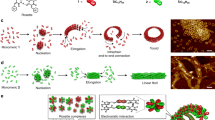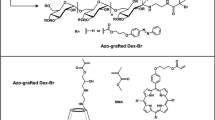Abstract
A deep understanding of the effect of the ionic density in a polymer on the solution properties would contribute to the development of novel stimuli-responsive materials. To this end, a multibranched and highly dense structure is an attractive platform for the accumulation of ionizable groups. In this study, we focus on core-crosslinked multiarm star polymers having ionizable poly(acrylic acid) (PAA) segments in the arms with different sequences to evaluate the density effect of ionic segments on pH-responsive properties. Two types of star polymers with a PAA block on the outer or inner side of an arm chain in combination with a hydrophilic poly(2-hydroxyethyl acrylate) (PHEA) block were synthesized via reversible addition-fragmentation chain transfer (RAFT) polymerization. These star polymers exhibited aggregation behavior different from the corresponding linear block polymer in an acidic aqueous solution. Dynamic light scattering analysis in water revealed that the star polymer with PAA in the outer layer formed larger aggregates than the star polymer with the inverse layer structure, and the pH-responsive change of the hydrodynamic radius in water depends on the sequence in the arm polymers. This behavior resulted from the balance of hydrogen bonding between PAA and PHEA segments and PAA electrostatic repulsion.
This is a preview of subscription content, access via your institution
Access options
Subscribe to this journal
Receive 12 print issues and online access
$259.00 per year
only $21.58 per issue
Buy this article
- Purchase on Springer Link
- Instant access to full article PDF
Prices may be subject to local taxes which are calculated during checkout











Similar content being viewed by others
References
Dai S, Ravi P, Tam KC. Thermo- and photo-responsive polymeric systems. Soft Matter. 2009;5:2513–33.
Roy D, Cambre JN, Sumerlin BS. Future perspectives and recent advances in stimuli-responsive materials. Prog Polym Sci. 2010;35:278–301.
Kocak G, Tuncer C, Bütün V. pH-Responsive polymers. Polym Chem. 2017;8:144–76.
Mane SR, Sathyan A, Shunmugam R. Biomedical applications of pH-responsive amphiphilic polymer nanoassemblies. ACS Appl Nano Mater. 2020;3:2104–17.
Li M-H, Keller P. Stimuli-responsive polymer vesicles. Soft Matter. 2009;5:927–37.
Alarcón CDH, Pennadam S, Alexander C. Stimuli responsive polymers for biomedical applications. Chem Soc Rev. 2005;34:276–85.
Schmaljohann D. Thermo- and pH-responsive polymers in drug delivery. Adv Drug Deliv Rev. 2006;58:1655–70.
Stuart MAC, Huck WTS, Genzer J, Müller M, Ober C, Stamm M, et al. Emerging applications of stimuli-responsive polymer materials. Nat Mater. 2010;9:101–13.
Bütün V, Armes SP, Billingham NC. Synthesis and aqueous solution properties of near-monodisperse tertiary amine methacrylate homopolymers and diblock copolymers. Polymer. 2001;42:5993–6008.
Narumi A, Fuchise K, Kakuchi R, Toda A, Satoh T, Kawaguchi S, et al. A versatile method for adjusting thermoresponsivity: synthesis and ‘Click’ reaction of an azido end-functionalized poly(N-isopropylacrylamide). Macromol Rapid Commun. 2008;29:1126–33.
Luo C, Liu Y, Li Z. Thermo- and pH-responsive polymer derived from methacrylamide and aspartic acid. Macromolecules. 2010;43:8101–8.
Lim J, Matsuoka H, Yusa S-I, Saruwatari Y. Temperature-responsive behavior of double hydrophilic carboxy-sulfobetaine block copolymers and their self-assemblies in water. Langmuir. 2019;35:1571–82.
Ida S, Nishisako D, Fujiseki A, Kanaoka S. Thermoresponsive properties of polymer hydrogels induced by copolymerization of hydrophilic and hydrophobic monomers: comprehensive study of monomer sequence and water affinity. Soft Matter. 2021;17:6063–72.
Kuckling D, Wycisk A. Stimuli‐responsive star polymers. J Polym Sci Part A: Polym Chem. 2013;51:2980–94.
Voit BI, Lederer A. Hyperbranched and highly branched polymer architectures—synthetic strategies and major characterization aspects. Chem Rev. 2009;109:5924–73.
Lee CC, MacKay JA, Fréchet JMJ, Szoka FC. Designing dendrimers for biological applications. Nat Biotechnol. 2005;23:1517–26.
Inoue K. Functional dendrimers, hyperbranched and star polymers. Prog Polym Sci. 2000;25:453–571.
Ren JM, McKenzie TG, Fu Q, Wong EHH, Xu J, An Z, et al. Star polymers. Chem Rev. 2016;116:6743–836.
Blencowe A, Tan JF, Goh TK, Qiao GG. Core cross-linked star polymers via controlled radical polymerisation. Polymer. 2009;50:5–32.
Gao H, Matyjaszewski K. Synthesis of functional polymers with controlled architecture by CRP of monomers in the presence of cross-linkers: from stars to gels. Prog Polym Sci. 2009;34:317–50.
Ida S, Toyama Y, Takeshima S, Kanaoka S. Thermoresponsive core cross-linked star-shaped poly(N-isopropylacrylamide) for reversible and controlled aggregation of nanoscale molecular units. Polym J. 2020;52:359–63.
Sharker KK, Takeshima S, Toyama Y, Ida S, Kanaoka S, Yusa S-I. pH- and thermo-responsive behavior of PNIPAM star containing terminal carboxy groups in aqueous solutions. Polymer. 2020;203:122735.
Connal LA, Li Q, Quinn JF, Tjipto E, Caruso F, Qiao GG. pH-responsive poly(acrylic acid) core cross-linked star polymers: morphology transitions in solution and multilayer thin films. Macromolecules. 2008;41:2620–6.
Qu C, Shi Y, Jing B, Gao H, Zhu Y. Probing the inhomogeneous charge distribution on annealed polyelectrolyte star polymers in dilute aqueous solutions. ACS Macro Lett. 2016;5:402–6.
Luo S, Xu J, Zhu Z, Wu C, Liu S. Phase transition behavior of unimolecular micelles with thermoresponsive poly(N-isopropylacrylamide) coronas. J Phys Chem B. 2006;110:9132–9.
Xu J, Luo S, Shi W, Liu S. Two-stage collapse of unimolecular micelles with double thermoresponsive coronas. Langmuir. 2006;22:989–97.
Plamper FA, Ruppel M, Schmalz A, Borisov O, Ballauff M, Müller AHE. Tuning the thermoresponsive properties of weak polyelectrolytes: aqueous solutions of star-shaped and linear poly(N,N-dimethylaminoethyl methacrylate). Macromolecules. 2007;40:8361–6.
Chen Q, Cao X, Liu H, Zhou W, Qin L, An Z. pH-responsive high internal phase emulsions stabilized by core cross-linked star (CCS) polymers. Polym Chem. 2013;4:4092–102.
Hou L, Chen Q, An Z, Wu P. Understanding the thermosensitivity of POEGA-based star polymers: LCST-type transition in water vs. UCST-type transition in ethanol. Soft Matter. 2016;12:2473–80.
Lang X, Lenart WR, Sun JEP, Hammouda B, Hore MJA. Interaction and conformation of aqueous poly(N-isopropylacrylamide) (PNIPAM) star polymers below the LCST. Macromolecules. 2017;50:2145–54.
Bywater S. Preparation and properties of star-branched polymers. Adv Polym Sci. 1979;30:89–116.
Kanaoka S, Sawamoto M, Higashimura T. Star-shaped polymers by living cationic polymerization. 1. Synthesis of star-shaped polymers of alkyl and vinyl ethers. Macromolecules. 1991;24:2309–13.
Baek K-Y, Kamigaito M, Sawamoto M. Star-shaped polymers by metal-catalyzed living radical polymerization. 1. Design of Ru(II)-based systems and divinyl linking agents. Macromolecules. 2001;34:215–21.
Barner-Kowollik C, Davis TP, Stenzel MH. Synthesis of star polymers using RAFT polymerization: what is possible? Aust J Chem. 2006;59:719–27.
Moad G, Rizzardo E, Thang SH. Living radical polymerization by the RAFT process. Aust J Chem. 2005;58:379–410.
Moad G, Rizzardo E, Thang SH. Living radical polymerization by the RAFT process—a second update. Aust J Chem. 2009;62:1402–72.
Gregory A, Stenzel MH. Complex polymer architectures via RAFT polymerization: From fundamental process to extending the scope using click chemistry and nature’s building blocks. Prog Polym Sci. 2012;37:38–105.
Swift T, Swanson L, Geoghegan M, Rimmer S. The pH-responsive behaviour of poly(acrylic acid) in aqueous solution is dependent on molar mass. Soft Matter. 2016;12:2542–9.
Loiseau J, Doërr N, Suau JM, Egraz JB, Llauro MF, Ladavière C, et al. Synthesis and characterization of poly(acrylic acid) produced by RAFT polymerization. Application as a very efficient dispersant of CaCO3, Kaolin, and TiO2. Macromolecules. 2003;36:3066–77.
André X, Zhang M, Müller AHE. Thermo- and pH-responsive micelles of poly(acrylic acid)-block-poly(N,N-diethylacrylamide). Macromol Rapid Commun. 2005;26:558–63.
Acknowledgements
The authors thank Prof. Dr. Takaya Terashima (Kyoto University) for performing SEC-MALS measurements and Ms. Yoko Mizoue (University of Hyogo) for assistance with DLS measurements.
Author information
Authors and Affiliations
Corresponding author
Ethics declarations
Conflict of interest
The authors declare no competing interests.
Additional information
Publisher’s note Springer Nature remains neutral with regard to jurisdictional claims in published maps and institutional affiliations.
Supplementary information
Rights and permissions
About this article
Cite this article
Kitajima, H., Ida, S., Bhowmik, S. et al. pH-responsive aggregation control of multiarm star polymers depending on the ionic segment sequence of arm polymers. Polym J 54, 715–725 (2022). https://doi.org/10.1038/s41428-022-00621-3
Received:
Revised:
Accepted:
Published:
Issue Date:
DOI: https://doi.org/10.1038/s41428-022-00621-3



